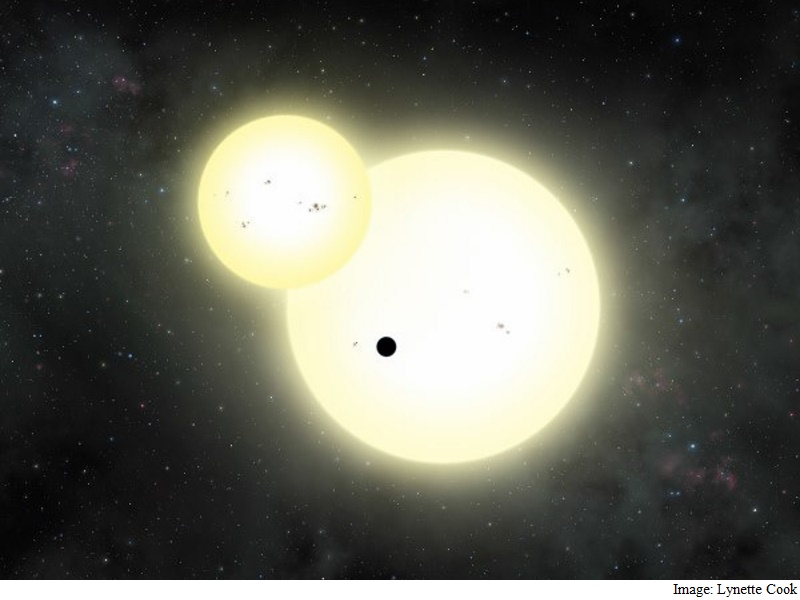- Home
- Science
- Science News
- Jupiter Like Planet That Orbits Two Suns Discovered
Jupiter-Like Planet That Orbits Two Suns Discovered

Situated in the constellation Cygnus, Kepler-1647b is 3,700 light-years away and approximately 4.4 billion years old - roughly the same age as the Earth - and orbits a binary-star system.
Kepler-1647b is a gas giant, making the planet unlikely to host life. Yet if the planet has large moons, they could potentially be suitable for life.
The stars are similar to the Sun, with one slightly larger than our home star and the other slightly smaller.
The planet has a mass and radius nearly identical to that of Jupiter, making it the largest transiting circumbinary planet ever found.
Planets that orbit two stars are known as circumbinary planets or sometimes "Tatooine" planets, after Luke Skywalker's home world in the movie "Star Wars".
"Finding circumbinary planets is much harder than finding planets around single stars.
The transits are not regularly spaced in time and they can vary in duration and even depth," said astronomer William Welsh from San Diego State University (SDSU) in California.
The planet takes 1,107 days - just over three years - to orbit its host stars, the longest period of any confirmed transiting exoplanet found so far.
The planet is also much further away from its stars than any other circumbinary planet, breaking with the tendency for circumbinary planets to have close-in orbits.
"It's a bit curious that this biggest planet took so long to confirm, since it is easier to find big planets than small ones," said SDSU astronomer Jerome Orosz. "But it is because its orbital period is so long."
Interestingly, its orbit puts the planet with in the so-called habitable zone - the range of distances from a star where liquid water might pool on the surface of an orbiting planet.
"Habitability aside, Kepler-1647b is important because it is the tip of the iceberg of a theoretically predicted population of large, long-period circumbinary planets," added Welsh.
The discovery was announced in San Diego at a meeting of the American Astronomical Society on Monday.
The research has been accepted for publication in the Astrophysical Journal with Veselin Kostov, a Nasa Goddard postdoctoral fellow, as led author.
Catch the latest from the Consumer Electronics Show on Gadgets 360, at our CES 2026 hub.
Related Stories
- Samsung Galaxy Unpacked 2025
- ChatGPT
- Redmi Note 14 Pro+
- iPhone 16
- Apple Vision Pro
- Oneplus 12
- OnePlus Nord CE 3 Lite 5G
- iPhone 13
- Xiaomi 14 Pro
- Oppo Find N3
- Tecno Spark Go (2023)
- Realme V30
- Best Phones Under 25000
- Samsung Galaxy S24 Series
- Cryptocurrency
- iQoo 12
- Samsung Galaxy S24 Ultra
- Giottus
- Samsung Galaxy Z Flip 5
- Apple 'Scary Fast'
- Housefull 5
- GoPro Hero 12 Black Review
- Invincible Season 2
- JioGlass
- HD Ready TV
- Laptop Under 50000
- Smartwatch Under 10000
- Latest Mobile Phones
- Compare Phones
- OPPO Reno 15 Pro Max
- Honor Win RT
- Honor Win
- Xiaomi 17 Ultra Leica Edition
- Xiaomi 17 Ultra
- Huawei Nova 15
- Huawei Nova 15 Pro
- Huawei Nova 15 Ultra
- Asus ProArt P16
- MacBook Pro 14-inch (M5, 2025)
- OPPO Pad Air 5
- Huawei MatePad 11.5 (2026)
- Xiaomi Watch 5
- Huawei Watch 10th Anniversary Edition
- Acerpure Nitro Z Series 100-inch QLED TV
- Samsung 43 Inch LED Ultra HD (4K) Smart TV (UA43UE81AFULXL)
- Asus ROG Ally
- Nintendo Switch Lite
- Haier 1.6 Ton 5 Star Inverter Split AC (HSU19G-MZAID5BN-INV)
- Haier 1.6 Ton 5 Star Inverter Split AC (HSU19G-MZAIM5BN-INV)

















